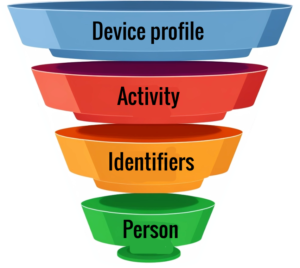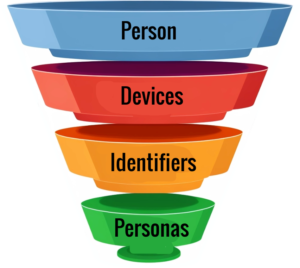This is part 2 in a 3-part series based on a presentation I did for Martech.org. I’ll post links to the other parts and to the full presentation below.
In a previous episode I introduced two frameworks for CDP use cases: the device framework and the person framework.
Today I’m going to show how you’d apply each of those frameworks to personalization.
Starting with the device framework (device, activity, identifiers, person), let’s start with what we can personalize at the device level.

- You can make the site responsive. That’s not a CDP use case, but it’s relevant to the subject.
- You can link to the correct app store — e.g., whether it’s Apple or Android.
- You can change the display if the user is in a certain location, like in or near your bricks and mortar store.
Based on activity, you can personalize based on pages visited, search terms, or products viewed. You can also personalize your site navigation based on a single user’s activity.
Identifiers include such things as …
- Did the user add a product to their cart? That doesn’t resolve to a person, but it does present opportunities for personalization.
- Did the user come to your site from an email? That can resolve to a person, but not with 100% accuracy.
- Did the user enter an email address? That much more accurately resolves to a person.
Once you have collected enough information to identify a person, you have more personalization options, such as showing renewal or account information.

Next is the person framework.
Imagine I run the Office Depot, and Joe is my customer. Joe has two accounts — one for his home office, one as an office manager for his work.
Joe also has many devices.
- Work phone
- Personal phone
- Work computer
- Home computer
Joe has multiple identifiers, including his work email address and three personal email addresses.
Here’s the trick. Joe doesn’t want you to merge all his records. He wants to maintain two distinct personas — one for his job and one for his side hustle.
Netflix understands this. They allow for different personas, so you can have a profile for Mom and Dad and a profile for the family.
Other systems fail at this, where they only allow one account to be associated with one phone number, for example.
By walking through both frameworks, you get a different perspective on how to manage and orchestrate your use case.
Links
Part 1: Two frameworks for CDP use cases
Part 3: Deterministic v probabilistic matching in a customer data platform
The full presentation: Two frameworks to harmonize identity and business needs




